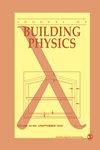Factors affecting the performance of ventilation cavities in highly insulated assemblies
IF 1.4
4区 工程技术
Q3 CONSTRUCTION & BUILDING TECHNOLOGY
引用次数: 3
Abstract
The article presents experimental studies of typical Finnish highly insulated (HI) envelopes with thermal resistance values (R value) for the wall and roof inside the ventilation cavity between 7.7 and 8.1 m2K/W and 13 m2K/W, respectively. The conditions in the ventilation cavities were studied by using typical and increased R values for the exterior part of the cavity, which were 0.18 m2K/W and 1.57 m2K/W in the walls, and 0.13 m2K/W and 2.13 m2K/W for the roof. With higher exterior R values of 1.57 m2K/W and 2.13 m2K/W, the cavity temperature increased only after closing the inlet gap of the cavities. If the cavity inlet was closed, the restriction of the outlet gap from 20–25 mm to 10 mm had no significant effect on the temperatures. A closed ventilation inlet resulted in increased absolute humidity in the cavity, which indicates that the restriction of cavity ventilation should be made with care to avoid impairing the drying-out ability. The computational analysis showed that the optimal air change rates in the wall and roof cavities of HI structures were 4–40 1/h and 20 1/h, respectively. The conventional 22-mm-thick wood cladding enables safe cavity conditions in HI walls if the vapor barrier is vapor tight and other moisture sources are low. A lower heat flux and additional heat loss caused by cloudless sky at night support the observation that HI roofs have a higher moisture risk. In HI roofs, a conventional exterior R value of 0.13 m2K/W should at least be increased to the range of 0.3–0.4 m2K/W, which is achieved, for example, by a 20-mm-thick mineral wool board under the roofing. The use of mold-resistant materials in the ventilation cavity is recommended to mitigate the possible ramifications of the moisture behavior of HI roofs.影响高度绝缘组件通风腔性能的因素
本文对芬兰典型的高绝热(HI)围护结构进行了实验研究,其通风口内墙体和屋顶的热阻值(R值)分别在7.7 ~ 8.1 m2K/W和13 m2K/W之间。采用典型的外腔R值(墙体R值分别为0.18 m2K/W和1.57 m2K/W,屋顶R值分别为0.13 m2K/W和2.13 m2K/W)和增大后的R值对通风腔内的条件进行了研究。当外部R值分别为1.57 m2K/W和2.13 m2K/W时,腔体温度只有在关闭入口间隙后才会升高。当空腔入口关闭时,出口间隙从20-25 mm限制到10 mm对温度没有显著影响。封闭的通风入口会增加空腔内的绝对湿度,这表明应谨慎限制空腔通风,以免损害干燥能力。计算分析表明,HI结构的最佳换气量分别为4 ~ 401 /h和201 /h。传统的22毫米厚的木材包层可以在蒸汽屏障是气密的和其他湿气源较低的情况下,在HI墙壁中提供安全的空腔条件。较低的热通量和夜间无云的天空造成的额外热损失支持了HI屋顶有较高受潮风险的观察。在高强度屋顶中,传统的0.13 m2K/W的外部R值至少应该增加到0.3-0.4 m2K/W的范围,例如,在屋顶下使用20毫米厚的矿棉板可以实现这一目标。建议在通风腔中使用防霉材料,以减轻HI屋顶潮湿行为的可能后果。
本文章由计算机程序翻译,如有差异,请以英文原文为准。
求助全文
约1分钟内获得全文
求助全文
来源期刊

Journal of Building Physics
工程技术-结构与建筑技术
CiteScore
5.10
自引率
15.00%
发文量
10
审稿时长
5.3 months
期刊介绍:
Journal of Building Physics (J. Bldg. Phys) is an international, peer-reviewed journal that publishes a high quality research and state of the art “integrated” papers to promote scientifically thorough advancement of all the areas of non-structural performance of a building and particularly in heat, air, moisture transfer.
 求助内容:
求助内容: 应助结果提醒方式:
应助结果提醒方式:


